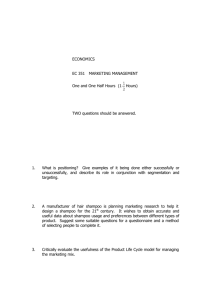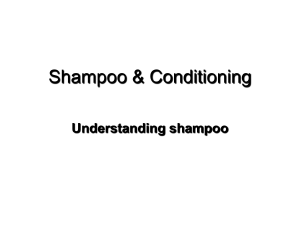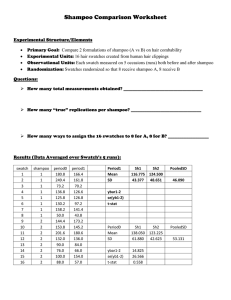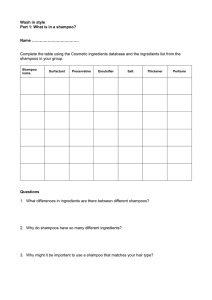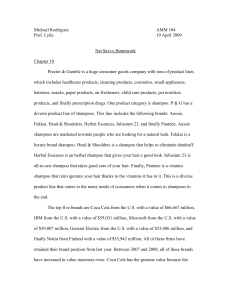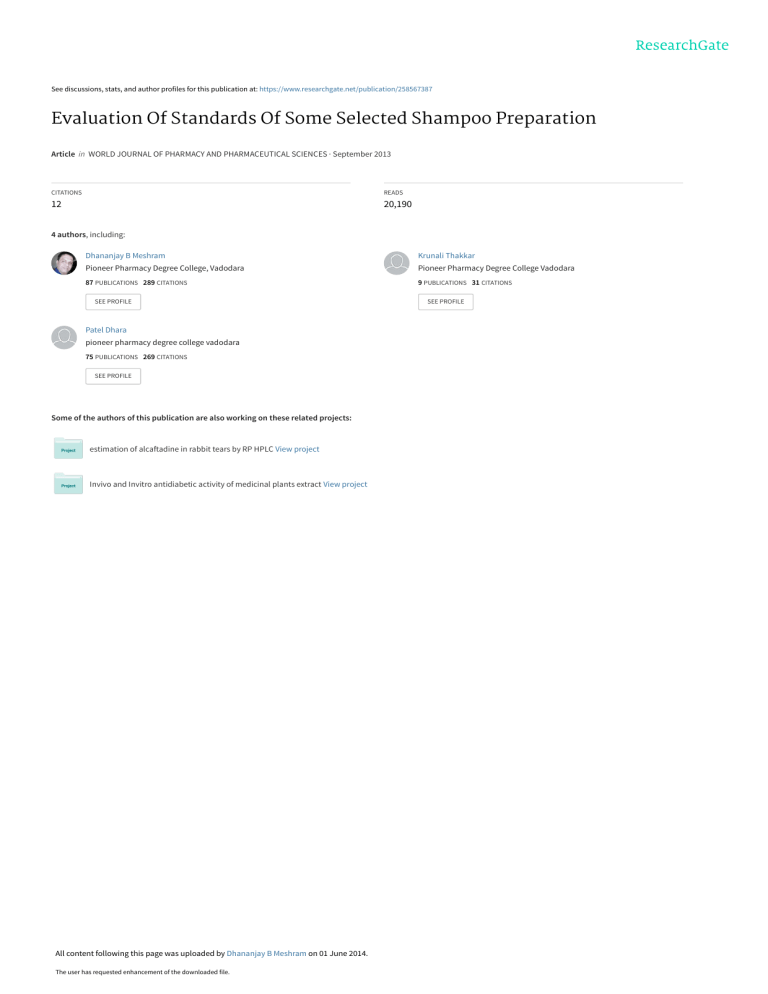
See discussions, stats, and author profiles for this publication at: https://www.researchgate.net/publication/258567387 Evaluation Of Standards Of Some Selected Shampoo Preparation Article in WORLD JOURNAL OF PHARMACY AND PHARMACEUTICAL SCIENCES · September 2013 CITATIONS READS 12 20,190 4 authors, including: Dhananjay B Meshram Krunali Thakkar Pioneer Pharmacy Degree College, Vadodara Pioneer Pharmacy Degree College Vadodara 87 PUBLICATIONS 289 CITATIONS 9 PUBLICATIONS 31 CITATIONS SEE PROFILE Patel Dhara pioneer pharmacy degree college vadodara 75 PUBLICATIONS 269 CITATIONS SEE PROFILE Some of the authors of this publication are also working on these related projects: estimation of alcaftadine in rabbit tears by RP HPLC View project Invivo and Invitro antidiabetic activity of medicinal plants extract View project All content following this page was uploaded by Dhananjay B Meshram on 01 June 2014. The user has requested enhancement of the downloaded file. SEE PROFILE WORLD JOURNAL OF PHARMACY AND PHARMACEUTICAL SCIENCES Krunali et al. World Journal of Pharmacy and Pharmaceutical Sciences Volume 2, Issue 5, 3622-3630. Research Article ISSN 2278 – 4357 EVALUATION OF STANDARDS OF SOME SELECTED SHAMPPOO PREPARATION Thakkar Krunali1*, Patel Dhara1, D.B Meshram1, Patel Mitesh2 1 Department of Quality Assurance, Pioneer Pharmacy Degree College, Vadodara-390019, Gujarat, India 2 Department of Pharmaceutics, Pharmacy Degree College, Vadodara-390019, Gujarat, India. Article Received on 05 August 2013, Revised on 25 August 2013, Accepted on 28 September 2013 ABSTRACT Hairs are the integral part of human beauty. Shampoos are primarily been products aimed at cleansing the hair and scalp. People are using herbs for cleaning, beautifying and managing hair since the ancient era. Shampoo is a hair care product used for the removal of oils, dirt, skin *Correspondence for particles, dandruff, environmental pollutants and other contaminant Author: particles that gradually build up in hair. The goal is to remove the * Thakkar Krunali .M. unwanted build-up without stripping out so much sebum as to make Pioneer Pharmacy Degree hair unmanageable. Five different formulations of various brands are College Vadodara-19 evaluated. Various parameters like physical parameters, Foaming Gujarat, India krunali_1708@yahoo.com, studies, cleaning action, wetting time etc are evaluated. KEYWORDS: Formulations, Evaluation, Shampoos. INTRODUCTION [1-8] Cosmetics are defined as "articles with mild action on the human body, which are intended to be applied to the human body through rubbing, sprinkling or other methods, aiming to clean, beautify and increase the attractiveness, alter the appearance or to keep the skin or hair in good condition hence a modern face powder is a blend of several constituents.[1-2] Cosmetics are products that are created for application on the body for the purpose of cleansing, beautifying or altering appearance and enhancing attractive features. Cosmetics are substances used to enhance the appearance or odour of the human body. [3] www.wjpps.com 3622 Krunali et al. World Journal of Pharmacy and Pharmaceutical Sciences Depending on the composition, a vehicle is used to exert mainly five types of effects on the skin cleansing, decoration, care, hydration and protection. Delivering active substance to the targeted site requires the right concentration of actives in the formulation to achieve the optimal release rate and desired distribution of active substances between the vehicle and target site. A cosmetic care product has to be developed and whenever this is the case, various issues and aspects have to be considered such as site and area of application, sensory and optical properties, state of matter, actives and final product storage stability and packaging. [4] The evaluation of cosmetics is very important to know their performance, quality and effectiveness. It is also necessary to check whether the products have any sensitivity toxic effects on human body. The work was done keeping the ideas of Bureau of Indian Standards to analyze the cosmetic products. So if the marketed product does not maintain the standards formed by the Bureau of Indian Standards various side effects like skin irritation, eye inflammation, hair falling, protein precipitation and heavy metal poisoning may occur. [5-6] A shampoo is a preparation of a surfactant (i.e. surface active material) in a suitable form – liquid, solid or powder – which when used under the specified conditions will remove surface grease, dirt, and skin debris from the hair shaft and scalp without adversely affecting the user. [7] Evaluation of shampoos comprises the quality control tests including visual assessment and physiochemical controls such as pH, density and viscosity. Sodium lauryl sulfate based detergents are the most common but the concentration will vary considerably from brand to brand and even within a manufacturer's product range. Cheap shampoos may contain a high detergent concentration while expensive shampoos may contain very little of a cheap detergent. [8] MATERIALS AND METHODS Shampoos (various different brand shampoos were were procured from local market) To evaluate the formulations, quality control tests including visual assessment and physicochemical controls such as pH, density etc were performed. Also, to assure the quality of products, specific tests for shampoo formulations including the determination of dry residue and wetting property, total surfactant activity, surface tension, and detergency tests were carried out. www.wjpps.com 3623 Krunali et al. World Journal of Pharmacy and Pharmaceutical Sciences EVALUATION OF SHAMPOO 1. PHYSICAL APPEARANCE/VISUAL INSPECTION [9] The formulations were evaluated in terms of their clarity, color, odor and texture. 2. DETERMINATION OF PH [10] PH of your 10% shampoo solution. Dip one strip of pH paper in the solution and compare the color of the strip to key. pH meter can also be used after calibration. Most shampoos are neutral or slightly acidic. Acidic solutions cause the cuticle (outer layer) of the hair to shrink and lay flatter on the shaft of the hair. Basic solutions cause the cuticle to swell and open up. Acidic solutions make the hair seem smoother. Basic solutions make hair seem frizzier. Neutral pH = 7 Acidic pH < 7 Basic pH >7 3. DIRT DISPERSION [11] Two drops of shampoo were added in a large test tube contain 10 ml of distilled water. 1 drop of India ink was added; the test tube was stoppered and shakes it ten times. The amount of ink in the foam was estimated as None, Light, Moderate, or Heavy. Shampoos that cause the ink to concentrate in the foam are considered poor quality. The dirt should vstay in the water portion. Dirt that stays in the foam will be difficult to rinse away. It will redeposit on the hair. 4. DETERMINATION OF PERCENTAGE SOLID CONTENT [12] A clean dry evaporating dish was weighed and added 4 grams of shampoo to the evaporating dish. The dish and shampoo was weighed. The exact weight of the shampoo was calculated only and put the evaporating dish with shampoo was placed on the hot plate until the liquid portion was evaporated. The weight of the shampoo only (solids) after drying was calculated. If a shampoo has too many solids it will be hard to work into the hair or too hard to wash out. If it doesn’t have enough it will be too watery and wash away quickly. A good shampoo will be between 20% – 30% solids. 5. SURFACE TENSION MEASUREMENT [13] Measurements were carried out with a 10% shampoo dilution in distilled water at room temperature. Thoroughly clean the stalagmometer using chronic acid and purified water. www.wjpps.com 3624 Krunali et al. World Journal of Pharmacy and Pharmaceutical Sciences Because surface tension is highly affected with grease or other lubricants. The data calculated by following equation given bellow: R2 = (w3-w2) n1 R2 (W2-w2)n2 where W1 is weight of empty beaker. W2 is weight of beaker with distilled water. W3 is Weight of beaker with shampoo solution. n1 is no. of drops of distilled water. n2 is no. of drops of shampoo solution. R1 is surface tension of distilled water at room temperature. R2 is surface tension of shampoo solution 6. CLEANING ACTION[14] 5 grams of wool yarn were placed in grease, after that it was placed in 200 ml. of water containing 1 gram of shampoo in a flask. Temperature of water was maintained at 350C. The flask was shaked for 4 minutes at the rate of 50 times a minute. The solution was removed and sample was taken out, dried and weighed. The amount of grease removed was calculated by using the following equation: DP = 100 (1-T/C) In which, DP is the percentage of detergency power, C is the weight of sebum in the control sample and T is the weight of sebum in the test sample. 7. WETTING TIME [15] The canvas was cut into 1 inch diameter discs having an average weight of 0.44 g. The disc was floated on the surface of shampoo solution of 1% w/v and the stopwatch started. The time required for the disc to begin to sink was measured acutely and noted as the wetting time. 8. FOAMING ABILITY AND FOAM STABILITY [16] Cylinder shakemethod was most widely used for determining foaming ability. 50 ml of the 1% shampoo solution was put into a 250 ml graduated cylinder and covered the cylinder with hand and shaken for 10 times. The total volumes of the foam contents after 1 www.wjpps.com 3625 Krunali et al. World Journal of Pharmacy and Pharmaceutical Sciences minute shaking were recorded. The foam volume was calculated only. Immediately after shaking the volume of foam at 1 minute intervals for 4 minutes were recorded RESULT AND DISCUSSION Table 1: Evaluation of Formulation for physical appearance, pH Sr.No Formulation Physical Appearance PH 1 F1 White, Shiny 5.53 + 0.03 2 F2 Black, Shiny 5.61 + 0.02 3 F3 Sky-blue, opaque 5.51 + 0.07 4 F4 Complete transparent 5.89 + 0.01 5 F5 White, Opaque 5.91 + 0.03 Table 2: Evaluation of Formulation for Surface tension and % solid contents Surface % Tension contents F1 32.43 + 0.031 17.75 + 0.02 2 F2 31.33 + 0.04 20.75 + 0.02 3 F3 32.12 + 0.12 22.25 + 0.02 4 F4 33.18 + 0.62 17.25 + 0.02 5 F5 32.66 + 0.34 24.00 + 0.02 Sr. No Formulation 1 solid Table 3: Evaluation of Formulation for wetting time, cleaning, and Detergency Sr. No Formulation 1 F1 2 Wetting time % cleaning % detergency 176 + 0.03 23.22 + 0.60 60.09 + 0.08 F2 179 + 0.77 21.67 + 0.56 61.98 + 0.98 3 F3 185 + 0.23 29.08 + 0.31 61.90 + 0.62 4 F4 172 + 0.34 21.35 + 0.08 64.56 + 0.12 5 F5 186 + 0.12 26.78 + 0.87 62.45 + 0.65 www.wjpps.com (sec) 3626 Krunali et al. World Journal of Pharmacy and Pharmaceutical Sciences Table 4: Foam stability of shampoos Time Foam volume (mins) F1 F2 F3 F4 F5 1 55 56 52 56 51 2 52 54 50 53 49 3 49 50 47 50 45 4 44 47 44 44 42 5 41 43 42 41 40 Foam volume 60 50 F1 Time 40 F2 30 F3 F4 20 F5 10 0 0 1 2 3 4 5 6 Volume Fig 1: Foam retention profiles of shampoos EVALUATION OF SHAMPOO 1. PHYSICAL TEST The results of visual inspection of series of formulations are listed in table 1. As can be seen, all formulations had the good characteristics with respect to foaming. 2. PH The pH of shampoos are found to important for improving and enhancing the qualities of hair, minimizing irritation to the eyes and stabilizing the ecological balance of the scalp. Mild acidity prevents swelling and promotes tightening of the scales, there by inducing shine. Thus the current trend is to promote shampoos of lower pH is one of the ways to minimize damage to the hair. All the three shampoo powders were acid balanced and were ranged 5.5 to 5.9, which is near to the skin pH. www.wjpps.com 3627 Krunali et al. World Journal of Pharmacy and Pharmaceutical Sciences 3. DIRT DISPERSION Shampoo that cause the ink to concentrate in the foam is considered poor quality, the dirt should stay in water. Dirt that stays in the foam will be difficult to rinse away. It will redeposit on the hair. All five shampoos showed similar results. These results indicate that no dirt retained in the foam; so prepared and marketed formulations are satisfactory. 4. SOLID CONTENTS If the shampoo has too many solids it will be hard to work into the hair or too hard to wash out. The result of percent of solids contents is tabulated in table 2. 5. SURFACE TENSION It has been mentioned that a proper shampoo should be able to decrease the surface tension of pure water to about 40 dynes/cm [17] . Surface tension reduction is one of the mechanisms implicated in detergency. The results are shown in Table 2. 6. CLEANING ACTION Cleaning action was tested on wool yarn in grease. Although cleaning or soil/sebum removal is the primary aim of a shampoo, experimental detergency evaluation has been difficult to standardize, as there is no real agreement on a standard soil, a reproducible soiling process or the amount of soil a shampoo should ideally remove. The results are presented in table 3. 7. WETTING TIME Wetting time of a substance is a function of its concentration. Drave’s test is the official test but generally canvas disc method is used as it is easy and time saving. Comparision results are shown in table 3. 8. FOAMING ABILITY AND FOAM STABILITY Although foam generation has little to do with the cleansing ability of shampoos, it is of paramount importance to the consumer and is therefore an important criterion in evaluating shampoos. All the five shampoos showed similar foaming characteristics in distilled water. The foam retention ability of five samples is given in figure 1. All five shampoos showed comparable foaming properties. The foam stability of herbal shampoos is listed in table 4 www.wjpps.com 3628 Krunali et al. World Journal of Pharmacy and Pharmaceutical Sciences REFERENCE 1. Minamoto K. Skin sensitizers in cosmetics and skin care products. Nippon Eiseigaku Zasshi. 65; 20-29 (2010). 2. Harry Cosmeticology seventh edition, Longmann, scientific and technical publication: Page no:285-287(1982) 3. Dureja H, Kaushik D, Gupta M, Kumar K, Lather V. Cosmeceuticals: An Emerging Concept. Indian J Pharmacol. 2005; 37(3):155-159. 4. Patravale VB, Mandawgade SD. Novel Cosmetic Delivery Systems: An Application Update. Int J Cosmetic Sci. 2008; 1:19- 33. 5. De Groot AC, Bruynzeel DP, Bos JD, Van der Meeran HL, Van Joost T, Jagtman BA, Weyland JW. The allergens in cosmetics. Arch Dermatol. 124; 1525-1529 (1998). 6. Draelos ZD. Active agents in common skin care products. Plast Reconstr Surg. 125; 719724 (2010). 7. Balsam, S.M., Gershon, S.D., Rieger, M.M., Sagarin, E., and Strianse, S.J.: COSMETICS–Science and Technology, 2 nd edition, Vol 2, John Wiley India, New Delhi, 2008 8. Eldridge J.M., Surfactant Science Series, (1997) 68, 83-104. 9. Aghel N., Moghimipour B. and Dana R.A., Iranian Journal of Pharmaceutical Research (2007) 6(3), 167-172. 10. Sharma, P.P.: COSMETICS Formulation, Manufacturing and Quality Control, 4th Edition, Vandana Publishers Pvt. Ltd., New Delhi, March 1998. 11. Ashok Kumar and Rakesh Roshan Mali evaluation of prepared shampoo formulation and to compare it with marketed formulation International Journal of Pharmaceutical Sciences Review and Research Volume 3, Issue 1, July – August 2010; Article 025 p.p 120-126 12. Salador, A., and Chisvert, A.: Analysis of cosmetic products, Elsevier, New York, 2006. 13. Gaud R.S. and Gupta G.D., Practical Physical Pharmacy, 1st ed., (2001) C.B.S. Publisher and Distributer, New Delhi, 81-105. 14. Sharma R.M, Shaha K,Patel J., Evaluation of prepared formulations and to compare formulated shampoo with marketed Shampoo, International Journal of Pharmacy and Pharmaceutical Sciences,3(4):402- 405,(2011) 15. Barel A.O., Paye M.,Maibach H.I., Handbook of Cosmetic Science and Technology. 423, 583-588, 773-775, (2001). 16. Klein K., Cosmetics and Toiletries magazine, (2004) 119 (10), 32-35. www.wjpps.com 3629 Krunali et al. World Journal of Pharmacy and Pharmaceutical Sciences 17. Ireland S., Carlino K., Gould L., Frazier F., Haycock P., Ilton S., Deptuck R., Bousfield B., Verge D., Antoni K., MacRae L., Renshaw H., Bialachowski A., Chagnon C., and Reddy K., Can. J. Neurosci. Nurs. (2007) 29(1), 14-9. www.wjpps.com View publication stats 3630
